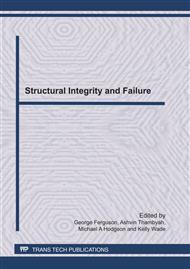[1]
D.L. Jones and D.B. Chisholm: An investigation of the edge-sliding mode in fracture mechanics, Engineering Fracture Mechanics, Vol. 7, No. 2 (1975), pp.261-270.
DOI: 10.1016/0013-7944(75)90007-7
Google Scholar
[2]
H.A. Richard: A new compact shear specimen, International Journal of Fracture, Vol. 17, No. 5 (1981), pp. R105-R107.
DOI: 10.1007/bf00033347
Google Scholar
[3]
T.M. Maccagno and J.F. Knott: The fracture behaviour of PMMA in mixed modes I and II, Vol. 34, No. 1 (1989), pp.65-86.
DOI: 10.1016/0013-7944(89)90243-9
Google Scholar
[4]
D. Bhattacharjee and J.F. Knott: Effect of mixed mode I and II loading on the fracture surface of polymethyl methacrylate (PMMA), International Journal of Fracture, Vol. 72, No. 4 (1995), pp.359-381.
DOI: 10.1007/bf00040373
Google Scholar
[5]
E. Sommer: Formation of fracture lances, in glass, Engineering Fracture Mechanics, Vol. 1, No. 3 (1969), pp.539-546.
DOI: 10.1016/0013-7944(69)90010-1
Google Scholar
[6]
W.G. Knauss: An observation of crack propagation in anti-plane shear, International Journal of Fracture Mechanics, Vol. 6, No. 2 (1970), pp.183-187.
DOI: 10.1007/bf00189825
Google Scholar
[7]
H.A. Richard and K. Benitz: A loading device for creation of mixed mode in fracture mechanics, International Journal of Fracture, Vol. 22, No. 2 (1983), pp. R55-R58.
DOI: 10.1007/bf00942726
Google Scholar
[8]
F. Ma, X. Deng, M.A. Sutton and J.C. Newman Jr: A CTOD-based mixed-mode fracture criterion, in Mixed-Mode Crack Behavior, ASTM STP 1359, edited by K.J. Miller and D.L. McDowell, American Society for Testing and Materials, West Conshohocken, PA (1999).
DOI: 10.1520/stp14245s
Google Scholar
[9]
A. Karpour and K. Zarrabi: Mixed mode I/II/III fracture grip interface, Innovation Patent 2008101040, Canberra, ACT, Australia (2008).
DOI: 10.2174/2212797611003020131
Google Scholar
[10]
A. Karpour and K. Zarrabi: A stereo machine vision system for measuring three-dimensional crack-tip displacements when it is subjected to elastic-plastic deformation, The E-Leader Conference at the Executive Media Theatre in Singapore, http: /www. g-casa. com/AboutUs. htm, Singapore, January 4-6 (2010).
Google Scholar
[11]
S. Liu, Y.J. Chao and X. Zhu: Tensile-shear transition in mixed mode I/III fracture, International Journal of Solids and Structures, Vol. 41, No. 22-23 (2004), pp.6147-6172.
DOI: 10.1016/j.ijsolstr.2004.04.044
Google Scholar


